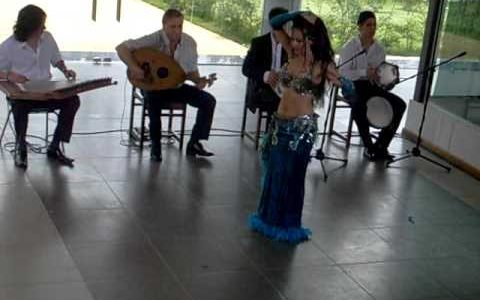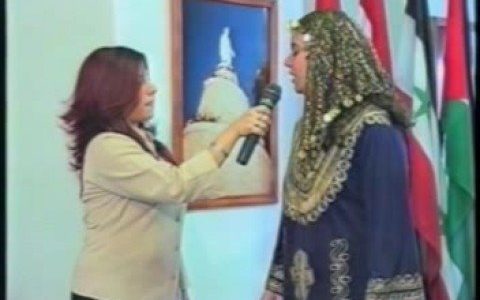Even though not translated yet, please watch this.
Lights of Arabia TV – Argentina
This is her website (Click Here)
You have to check out that video and her website to see just how big Arabic Dancing is on a national level in Argentina.
Even though not translated yet, please watch this.
Lights of Arabia TV – Argentina
This is her website (Click Here)
You have to check out that video and her website to see just how big Arabic Dancing is on a national level in Argentina.

Mario Kirlis is technically an Argentine, but has a wide fan base all over South America, and not just among the Arab community.
This was a show of him on Uruguayan TV
Source: https://www.youtube.com/watch?v=kZXEXSglfVQ
Fadwa, directora de la escuela de danzas árabes ‘Nur al Ámar’ (Montevideo Uruguay) en los estudios del canal 5 junto a la gran orquesta árabe de Mario Kirlis:
:: Mario Kirlis en Laud
:: Gaston Chaade en Qanun
:: Matias Hazrum en Derbake
:: Pablo Ventura en Massar y DaffEs una improvisacion del tema Aziza que la orquesta interpreta para el programa “Igualito” en Canal 5 conducido por Omar Gutierrez, previo a la muestra anual de alumnas y show arabes en Sala Zitarrosa el pasado lunes 23 de Noviembre.
Fadwa, director of the school of Arabic dance: ‘Nur al Ámar’ (Montevideo Uruguay) in the studios of channel 5 along with the grand orchestra of Mario Kilis:
:: Mario Kirlis on Lute
:: Gaston Chaade en Kanun (Arabic Zither)
:: Matias Hazrum pn Derbake (Arabic Drum)
:: Pablo Ventura on Massar y Daff (I have no idea)It is an improvisation of the Aziza theme that the orquestra interprets for the program “Igualito” on Canal 5, directed by Omar Gutierrez, prior to the annual Arab exhibition, in Zitarrosa Hall, of students and show on Monday 23 November [2009].
What is interesting is how mainstream this is in South America.

August 4, 2012
Argentina has approximately 45 million people.
Somewhere between 3 and 4 million Argentines have some degree of Arabic ancestry; most being either Syrian Orthodox or Lebanese, who are often Maronite Catholic. While Palestinians are found among them, they do not have the same clout that Palestinians have in Chile, where the Palestinians are the majority of the Arab community.
The Syrio-Lebanese seem to be more interested in blending in to Argentine society that the Arabs are in other countries.
The Arabs in Argentina have an ethnic collective organization: FEARAB-Argentina (Federation of Arab Societies in Argentina).
FEARAB-Argentina also maintains a Facebook page.

Former FEARAB-Argentina Website banner (Federation of Arab Societies in Argentina) circa 2012
(Click Here) for archive of website
One of the pictures on the old header was of a gaucho1 against images of Syria and Lebanon, which was more a message of an assimilating Arab ethnic group which wanted to be Argentine. The Arab-Argentines do not seem to be as strongly politicized as Chilean Arabs, where the Palestinian-Chilean community presently seems to have a strong anti-Israel view.
The former website for FEARAB-Chile (Federation of Arab Societies in Chile) used to have a map of Palestine that erased Israel altogether.

Former Header on FEARAB-Chile website – Israel was erased from the map.
The present page for FEARAB-Chile is still highly politicized against Israel.
Clearly, with Palestinians less of a constituency in Argentina, and Lebanese more strongly represented, a more moderate view seems to operate among Argentine Arabs.
What you are more likely to see in Argentina’s Arabs is more of a concentration on culture and heritage. The Palestine issue may come up, but it is not as central to their identity.
Again, this seems to be the moderating influence of a large Maronite community from Lebanon. The Christians in Lebanon were terribly persecuted by Muslims, so they tend to shy away from any cause which has a Muslim indentity. Hence, they downplay the Israel/Palestine conflict.
This TV show (below) is more typical:
Dami U Damak (Arabic for Blood to Blood) – 2008 Season – Show #100 Part 1 (Source)
NOTE: Only the opening song is in Arabic, the rest is in Spanish.
From San Luis, in Central Argentina.
Notice how the show shows Christian priests, in the opening. Notice how the women seem quite liberated.
This show seems to be a retrospective show (It is their 100th show) and so they went over some past shows, and stories.
Notice at (5:30) the memorial to victims of the Lebanese-Israel war. Notice the Argentine flag in the crowd. These people are integrated.
What should be clear here is that in Argentina the vast majority of Arabs are Christians, and assimilated ones at that. They set the cultural tone. Actually, there was a resevoir of anger at Muslim extremism after the AMIA bombing of 1994. The Arabs in Argentina were quick to distance themselves from it; and since the vast majority are Christian, this was not too hard.
Most Arabs have assimilated exceptionally well into Argentina with a large degree of intermarriage with other ethnic-Argentines.
1There is good reason to believe that part of gaucho apparel hails from Moriscos (Hispanicized Moors – lit: Moorish Ones) who came to South America. That is a story in itself; but there is a debate whether the word gaucho comes from Indian tongues or from a Arab-Moorish word for cow herder. I lean towards the Arab-Moorish view.
Source: ElAljibedetodos, a viewer who assembled hundreds of these videos on his YouTube channel.
In 1609, Catholic Spain expelled almost all of the remaining Moriscos from the country, even many who had sincerely converted to Catholicism. The Spanish just did not trust them. It is believed that many of these Moriscos went to Latin America.
Many of these Moriscos made it to Argentina, rather than be expelled to North Africa. Expecting equal treatment in the colonies, they were often abused as racially inferior. Many of them deserted into the interior where they mixed with Spanish outcasts, Basque adventurers, Indians, and later black slaves, to produce a new stock … which would become the gauchos. They would eventually totally Catholicize (if they were not Catholic already), losing any connection with their Arab roots, except their wardrobes which smack of an oriental fashion, not a European Spanish one.
The image we have of the gaucho now is white. This was the product of massive white immigration to Argentina in the mid to late 19th century. But when Argentina fought Spain for its independence, in the 1810s, massive white immigration had yet to start. The gauchos were quite mestizo. They played havoc with the Royal Spanish Armies and drove them out of the interior of Argentina, during the Gaucho Wars. They were responsible, to a large part, for Argentina’s Independence since the Spanish Armies were no match for them.
In the end, the gaucho descendents of the Moriscos got their revenge. The Spanish government threw them out of Spain. Their descendents would throw the Spanish goverment out of Argentina.
The Arabs of Argentina take pride in this, though with some degree of exaggeration. Most Arab-Argentines arrived long after the gaucho wars, and during the time of European immigration. Most old line gauchos (from pre-1870 stocks) are probably not aware of any possible Morisco ancestry, and would indentify as Spanish or Basque with possibly a mix of Indian. Newer gauchos, of post 1870 ancestry, would be of European, often Basque or Irish, stock.
The red neck kerchief of the gaucho is clearly European Basque in ancestry. A lot of gauchos wear berets instead of gaucho sombreros. The beret would be Basque in origin.
But, even if exaggerated, the picture of the gaucho shows that Argentine-Arabs identify with Argentina.
3 May 2021 – Edited: Updated info, cleaned up writing, made more mobile friendly, and made a lot of changes.
June 29, 2012
This site is about an attempt for peace; an attempt to demolish all stereotypes and think outside the box.
– If you came to this site to find some bigot who trashes Zionists, then forget it. Go somewhere else.
– If you came to this site to find some bigot who trashes Arabs, then forget it. Go somewhere else.
– If you came to this site to find some politically correct defense of this or that foreign policy, then forget it. Go somewhere else.
– This site is going to examine an aspect of Arab and Latin History than most of the world knows nothing about.
– This site is going to examine the present conditions in Latin America, and the Arab World, to see if peace can be obtained (even if only partially) by taking unique advantage of the history of Latin America vis a vis Arabs.
What happened?
Desde El Aljibe – Argentina Public TV – 2005
Credit/Source: ElAljibedetodos
NOTE: At the ending there are Argentine sponsors,
and Argentina’s Channel 7 credits
In the spring of 2011, as I was studying my Spanish, I wandered by accident on to a serious of internet videos and websites which showed an amazing Arab subculture in South America. I had not expected this at all, let alone the enormity of it.
The more I researched it, the more I was utterly amazed. Each video lead to 10 more. Each website to 20 more. Pretty soon, I had discovered a mighty, thriving subculture that few people outside of Latin America knew about.
What I found out?
To my utter amazement I found out:
1) There are more than 20 plus million Arabs in South America and millions more in Central America and Latin America.
2) They are not merely middle class, but many are the elites of their societies.
3) The vast majority are Christian, though they did not all arrive as Christians.
4) They have assimilated exceptionally well.
5) Most are intermarried and/or do not speak Arabic any more.
6) But while their Arabic language was lost, the culture and cuisine, and pride were not.
7) We never hear about this in the USA because our media is biased.
8) Arab culture is a major subculture in Latin America. Unlike in the USA, it is not despised; but regarded highly, especially in light of their communal success.
9) If we realign our thinking, maybe the West can use South America to be a bridge to the Mideast, and maybe Latin America can provide a refuge for some Palestinian refugees who have no where else to go.
Not bad thing for a non-Arab, non-Hispanic American to wander into on the internet.
I wish I were younger. My middle aged brain struggles with basic Spanish. Were I in my teens, I would be learning both Spanish and Arabic.
Put aside your prejudices and pre-conceived notions. South American Arab culture will evaporate everyone of them.
¡Disfrute! Enjoy!